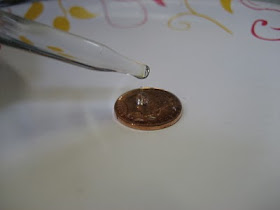The surface of the water has a layer of clingy molecules on it. This layer is called the water's surface tension.
The students in the Year 5/6 science club did some investigations to demonstrate surface tension.
In the first investigation we dropped drops of water onto a coin and counted how many it could hold before it overflowed.

 We tested clean water and soapy water. We found that clean water was able to hold a lot more drops that soapy water. The average for clean water was 24. The average for soapy water was 14.
We tested clean water and soapy water. We found that clean water was able to hold a lot more drops that soapy water. The average for clean water was 24. The average for soapy water was 14.We thought this was because the soap took up more space on the coin because of the bubbles. But Miss Harrison explained to us that the soap breaks the surface tension of the water so the bubble is not as strong.
 This investigation showed what happens when the surface tension on the water was broken. First we sprinkled pepper on top of the water. Then we dipped our finger in soap and then dipped it into the middle of the bowl. The pepper suddenly spread away from our finger.
This investigation showed what happens when the surface tension on the water was broken. First we sprinkled pepper on top of the water. Then we dipped our finger in soap and then dipped it into the middle of the bowl. The pepper suddenly spread away from our finger.
This video showed what we did for our last investigation. (Sorry about the sideways shots - Miss Harrison had her camera turned around the wrong way!)
This is what we learned during the lesson.
Jack
Water likes to stick together but the soap separates it when it breaks the surface tension.
Shikhar
The dishwashing liquid molecules breaks the surface tension of the water so the toothpicks separate from each other as the water moves.
Russell
The soap breaks up the surface tension. This works because water molecules like to stick together. But since soap likes to break things up it moves the water away to the sides.

G1 love reading about what is happening in Science. We think Cameron and Max are awesome scientists.
ReplyDeleteWOW, we did this same experiment while adding another category, slightly soapy water. We got the same results and our explained and directed us to your site to learn more about surface tension.
ReplyDeleteThanks,
A student